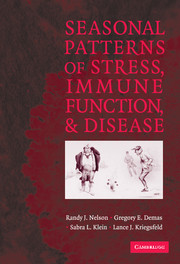Book contents
- Frontmatter
- Contents
- Acknowledgments
- Foreword
- Preface
- 1 Seasonality
- 2 Immune Function
- 3 Seasonal Fluctuations in Disease Prevalence
- 4 Seasonal Changes in Immune Function
- 5 Photoperiod, Melatonin, and Immunity
- 6 Energetics and Immune Function
- 7 Hormonal Influence on Immune Function
- 8 Clinical Significance of Seasonal Patterns of Immune Function and Disease
- References
- Index
Foreword
Published online by Cambridge University Press: 11 November 2009
- Frontmatter
- Contents
- Acknowledgments
- Foreword
- Preface
- 1 Seasonality
- 2 Immune Function
- 3 Seasonal Fluctuations in Disease Prevalence
- 4 Seasonal Changes in Immune Function
- 5 Photoperiod, Melatonin, and Immunity
- 6 Energetics and Immune Function
- 7 Hormonal Influence on Immune Function
- 8 Clinical Significance of Seasonal Patterns of Immune Function and Disease
- References
- Index
Summary
Most animals exhibit seasonal variation in their reproduction and survival simply because most of them live in environments in which food availability varies seasonally. This is true in the tropics as well as at the higher latitudes, but at the higher latitudes the combined challenge of food shortage and low temperature makes winter a particularly difficult time to reproduce and survive.
Traditionally, vertebrate physiologists interested in seasonal phenomena have focused on reproduction and largely ignored survival. In part, this is because of the discovery 70-odd years ago that some temperate zone animals use variation in day length to synchronize their reproduction with seasonally changing environmental conditions. This discovery meant that researchers interested in seasonality could bring the power of the scientific method into play simply by installing a light timer on the wall of an animal room. The result of several decades of experimentation using this technique is a robust body of knowledge about how photoperiod regulates reproduction. Indeed, this is an epic, albeit an as yet unfinished epic, in biological research.
Randy Nelson and his colleagues have added a whole new dimension to the study of seasonality by shifting the focus from reproduction to survival. This book is a pioneering effort to define this field of study, and it will prove to be a milestone in research on seasonality. The specific hypothesis under consideration is that “individuals have evolved mechanisms to bolster immune function in order to counteract seasonally recurrent stressors that may otherwise compromise immune function.” Stated differently, the authors visualize seasonal variation in survival as an interaction between two factors: the suppression of immune response attributable to changing energetic conditions and an endogenous rhythm of enhancement of immune response that is dependent on photoperiod, clocks, and melatonin.
- Type
- Chapter
- Information
- Seasonal Patterns of Stress, Immune Function, and Disease , pp. xi - xiiPublisher: Cambridge University PressPrint publication year: 2002
- 1
- Cited by



